Tom's Guide Verdict
The Galaxy S22 Ultra has some competition for the title of best Android phone. The OnePlus 10 Pro is sleek, powerful and long-lasting, with the best cameras ever included on a OnePlus phone.
Pros
- +
Excellent battery life
- +
Beautiful new design
- +
OxygenOS 12 is nice to use
- +
Best OnePlus cameras to date
- +
Lower price than last year
Cons
- -
No mmWave or AT&T 5G
- -
Only 3 years of updates
- -
Telephoto camera is just 8MP
Why you can trust Tom's Guide
While it took some time for this OnePlus 10 Pro review to arrive, we're glad the phone's finally here. After spending a month and a half in early 2022 as a China-only exclusive, you can now buy the company's latest flagship phone in the U.S. and the U.K.. And the good news is you'll want to. This is OnePlus' most complete phone yet, and has become one of our best Android phone picks.
Price: $899
Android version: 12, OxygenOS 12.1
Display: 6.7-inch AMOLED (3216 x 1440)
Refresh rate: 1-120Hz
CPU: Snapdragon 8 Gen 1
RAM: 8GB, 12GB
Storage / Expandable: 128GB, 256GB / No
Rear cameras: 48MP (f/1.8) main, 50MP (f/2.2) ultrawide, 8MP (f/2.4) 3.3x telephoto
Front camera: 32MP (f/2.2)
Video: Up to 8K 30 fps, 4K 120 fps, 1080p 240 fps
Battery: 5,000 mAh
Battery life (Hrs:Mins): 11:52 (120Hz), 12:39 (60Hz)
Size: 6.42 x 2.91 x 0.34 inches
Weight: 7 ounces
Colors: Volcanic Black, Emerald Forest
From the improved cameras to the gorgeous display and beautiful design, the OnePlus 10 Pro certainly gives the Samsung Galaxy S22 Ultra a run for its money. I’m hard-pressed to say which phone is better, since OnePlus hasn’t been able to match Samsung’s new update policy — nor does the OnePlus 10 Pro have the S22 Ultra’s productivity potential. Now that the OnePlus 10T has launched, you can check out our full comparison between OnePlus 10T vs. OnePlus 10 Pro to know which is the better OnePlus flagship.
We've got more advice on this tricky decision in our Samsung Galaxy S22 Ultra vs. OnePlus 10 Pro face-off. And also see how the OnePlus 10 Pro's camera compares to the best camera phones.
But in practically every other area, the OnePlus 10 Pro matches the Galaxy S22 Ultra and for hundreds of dollars less. At $899, this phone costs less than the $1,199 S22 Ultra. The other elephant in the room is the Pixel 6 Pro, which matches the $899 price of the OnePlus 10 Pro and offers formidable cameras.
This is the best handset from OnePlus, and in this OnePlus 10 Pro review, I’ll tell you exactly why it’s my new favorite Android device. Also see our quick summary of OnePlus 10 Pro reasons to buy and skip, and how it matches up against our current top phone in our OnePlus 10 Pro vs. iPhone 13 Pro Max face-off.
OnePlus 10 Pro review: Price and release date
The OnePlus 10 Pro has been on sale since April, originally debuting at $899 for a model with 8GB of RAM and 128GB of storage. With the advent of the OnePlus 10T, though, OnePlus has dropped the price on its flagship device. You can now get the OnePlus 10 Pro for $799, a $100 drop from the original cost. A 12GB/256GB version is available for $869.
In addition to being on sale through the OnePlus website, you can buy the phone at Amazon and Best Buy. T-Mobile offers the phone as well.
Get instant access to breaking news, the hottest reviews, great deals and helpful tips.
The most comparable models to the OnePlus 10 Pro include the $899 Pixel 6 Pro, $999 iPhone 13 Pro, and the $999 Galaxy S22 Plus (or $799 Galaxy S22). But I think the most apt comparison in many regards is the Galaxy S22 Ultra, which starts at $1,199 and features the powerful S Pen stylus and crazy telephoto zoom strengths. Even lacking those capabilities, the OnePlus 10 Pro still measures up well to the best Samsung phone, and it now costs $400 less.
You can save even more with the OnePlus 10T, which starts at $649 and has a faster chipset than the OnePlus 10 Pro. But you'll sacrifice camera performance for the less expensive device.
OnePlus 10 Pro review: Design
OnePlus has steadily improved its design chops in recent years, but the OnePlus 10 Pro is a step above even the OnePlus 9 Pro. I received the Volcanic Black model which features a soft touch material on the back. One of my favorite parts about this is that the phone is now resistant to fingerprints, something its predecessor could not claim.
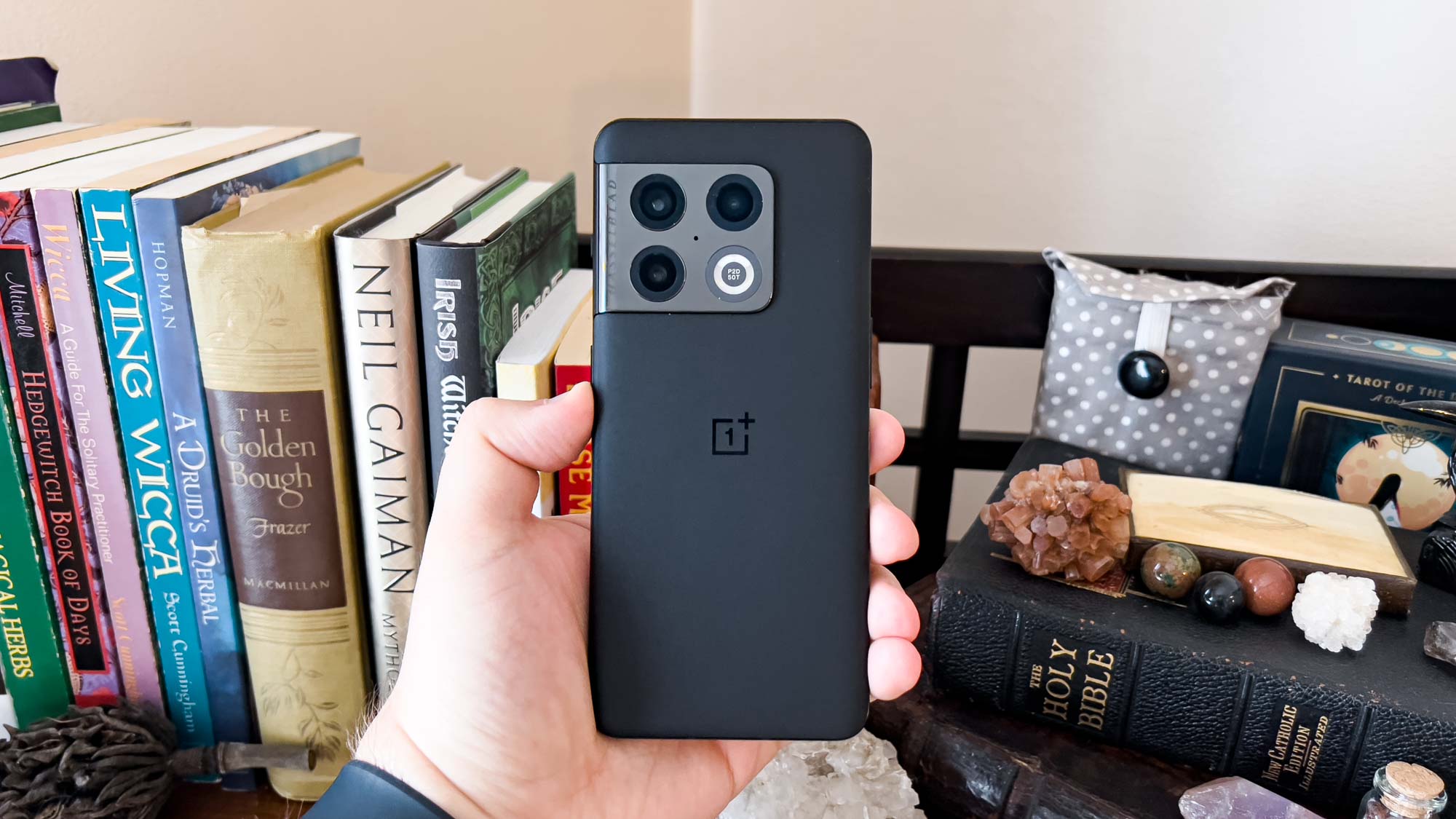
You might have noticed the new camera module design, which takes obvious cues from Samsung. The whole array blends into the frame seamlessly, much like the Galaxy S22’s contour cut. Made with ceramic, the OnePlus 10 Pro’s camera module is durable and eye-catching, even though I only really see a stovetop when I look at it.

The alert slider, a staple of OnePlus phones since the OnePlus 2, is still here and as useful as ever. iPhones have something similar to this hardware switch, but I have yet to see an Android phone adopt the slider. It’s incredibly useful for setting the OnePlus 10 Pro to vibrate or silencing it outright. I love it and I love that OnePlus has kept it around — it shows that some of the company’s old design language persists.

Overall, the OnePlus 10 Pro feels very nice to hold. At just 7 ounces, it’s surprisingly light in my hand. With a width of 3 inches, I don’t need to stretch my thumb too far to reach parts of the screen.
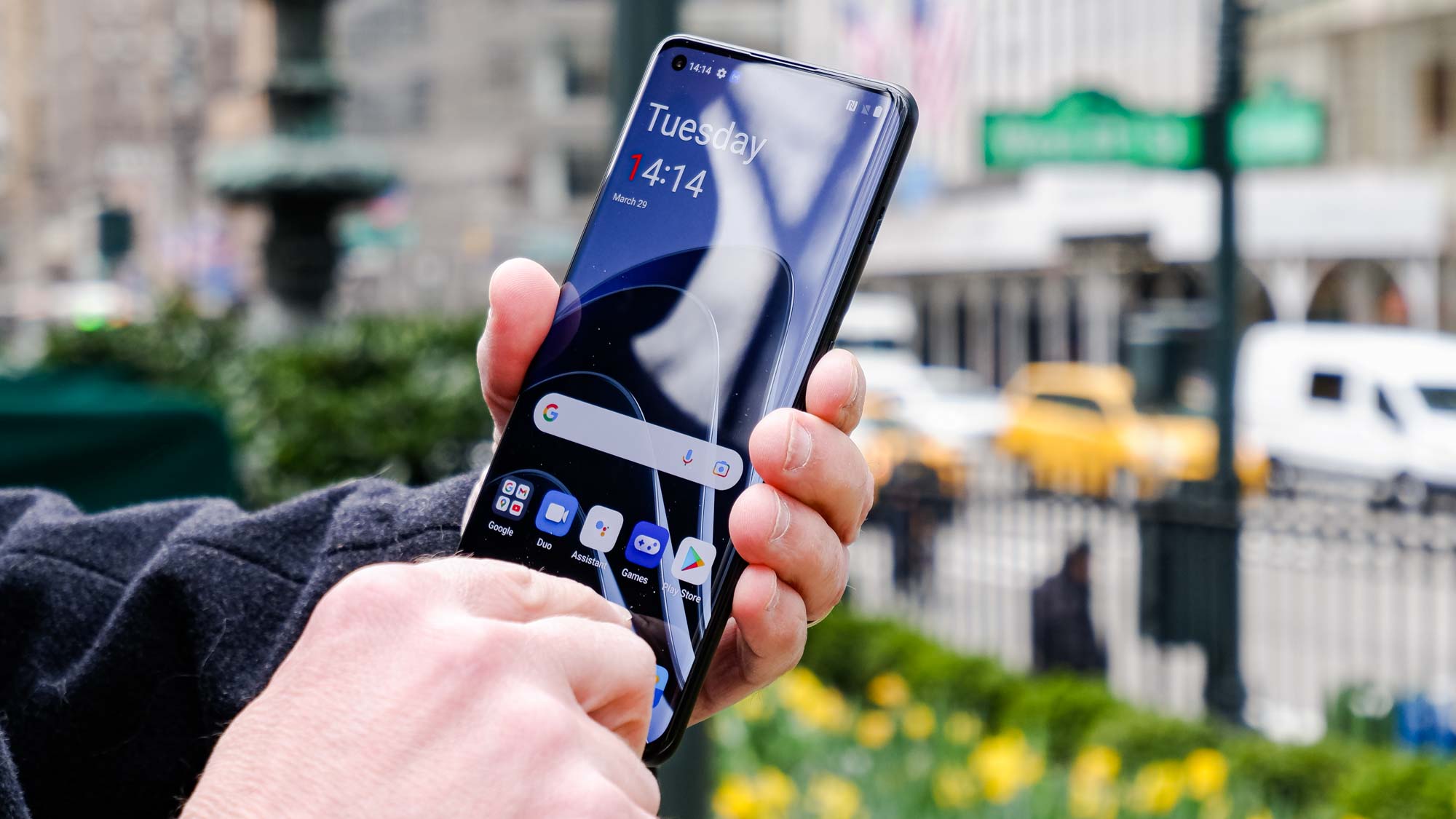
The OnePlus 10 Pro is narrower and lighter than the Galaxy S22 Ultra. So OnePlus made a very comfortable phone to hold, though it’s still quite large.
OnePlus 10 Pro review: Display
I really liked the display on the OnePlus 9 Pro, but the OnePlus 10 Pro takes it a step above. At 6.7 inches with a QHD resolution, it’s a big and immersive AMOLED panel.
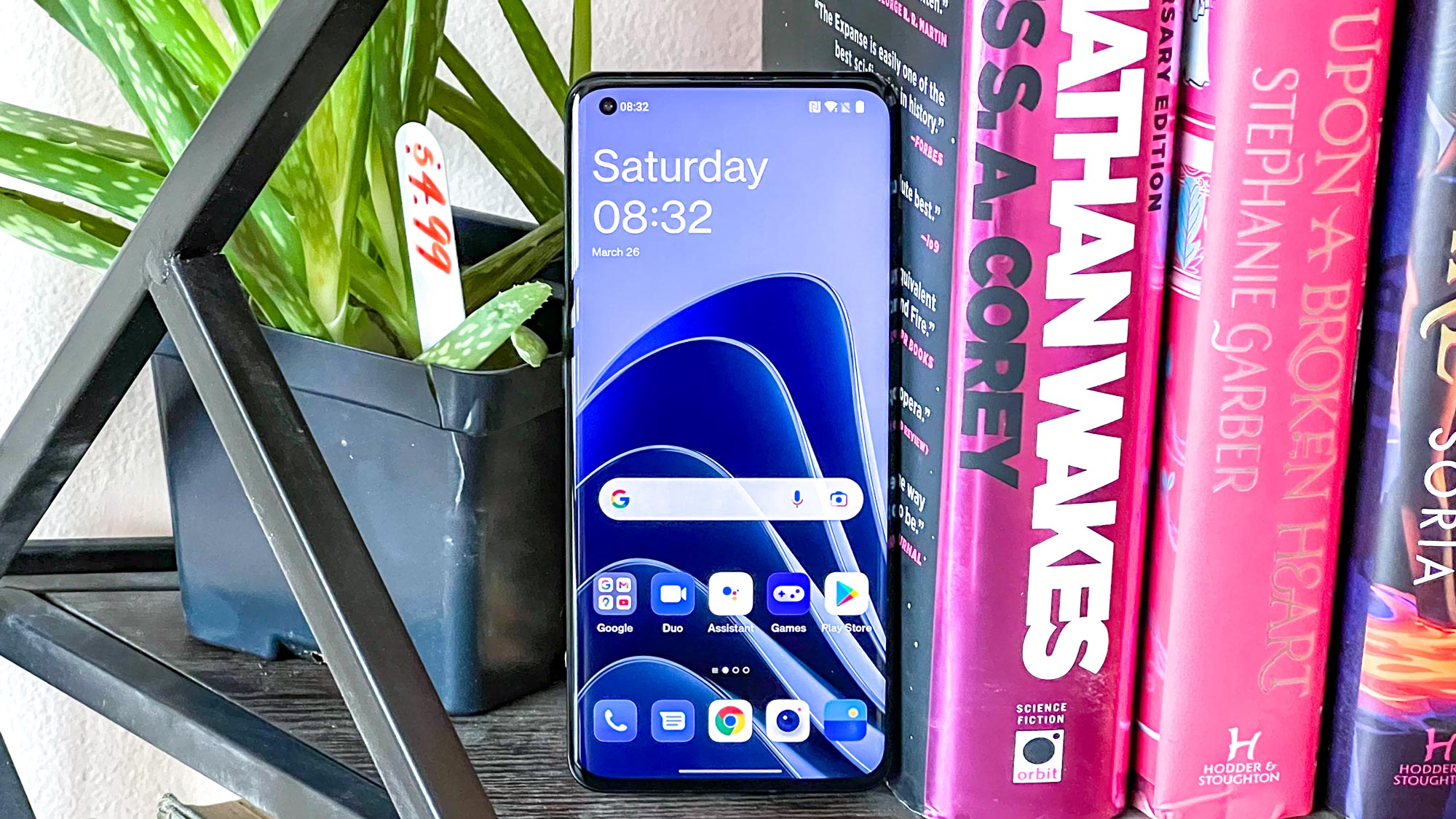
The OnePlus 10 Pro also uses second-generation LTPO technology, allowing the display to intelligently scale its refresh rate between 1Hz and 120Hz depending on the on-screen content. You can also choose between FHD+ and QHD+ for your resolution, the former of which saves on battery life.

I absolutely love watching videos and playing games on the OnePlus 10 Pro display. For example, Blade Runner 2049 looks dreary and grim even amongst the neon, drawing me into the film’s gritty world. But watching the trailer for Disney+’s Obi-Wan show, the OnePlus 10 Pro immediately pulled me into the drama surrounding one of the greatest Jedi masters.
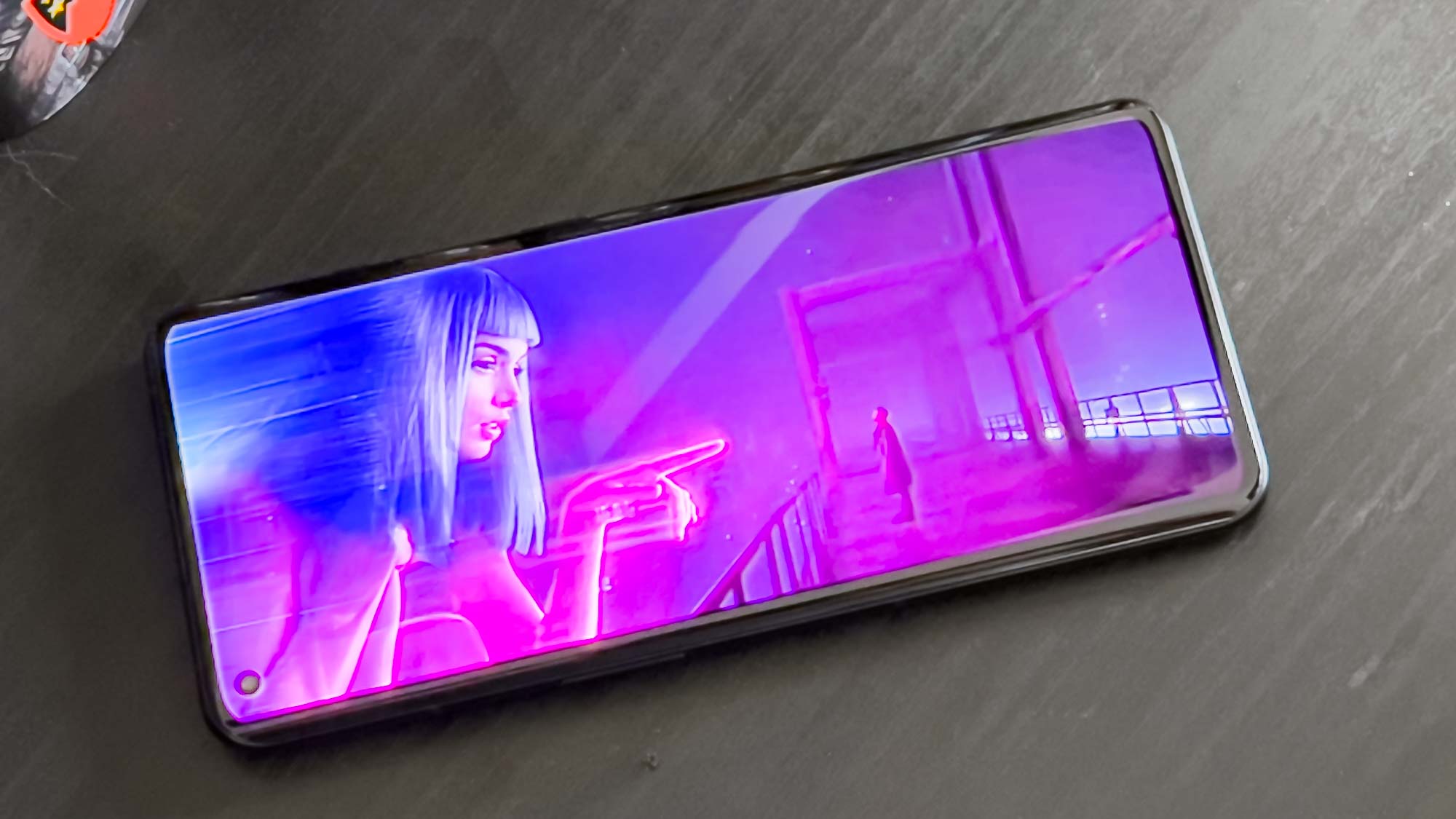
Here is how the OnePlus 10 Pro stacks up against the Galaxy S22 Ultra in our display testing. I’ve also included the OnePlus 9 Pro so that you can see how the last two generations of OnePlus phones compare.
| Row 0 - Cell 0 | OnePlus 10 Pro (Vivid / Natural) | Galaxy S22 Ultra (Natural) | OnePlus 9 Pro (Vivid / Natural) |
| Display size | 6.7 inches | 6.8 inches | 6.7 inches |
| sRGB (%) | 173.6 / 119 | 137.5 | 208.1 / 119.9 |
| DCI-P3 (%) | 123 / 84.3 | 97.4 | 147.4 / 84.9 |
| Delta-E | 0.32 / 0.23 | 0.25 | 0.32/ 0.2 |
| Peak brightness (nits) | 734 (SDR), 715 (HDR) | 644 (SDR), 1,359 (HDR) | 722 (SDR) |
As you can see, OnePlus dialed back the Vivid color saturation this year versus the OnePlus 9 Pro, but kept the same Natural profile. Compared to the Galaxy S22 Ultra’s Natural setting, the OnePlus 10 Pro doesn’t reproduce as much of either the sRGB or DCI-P3 color gamuts. When it comes to the Delta-E color accuracy score (where 0 is perfect), the OnePlus 10 Pro fell just a bit when compared to its predecessor, but scored a bit better than the Galaxy S22 Ultra.
In practice, however, the OnePlus 10 Pro has a beautiful display. In a world where the Galaxy S22 Ultra doesn’t exist, I’d say this phone has the best display on an Android phone. But the S22 Ultra set the bar high this year. It’s jaw-droppingly gorgeous and very bright.
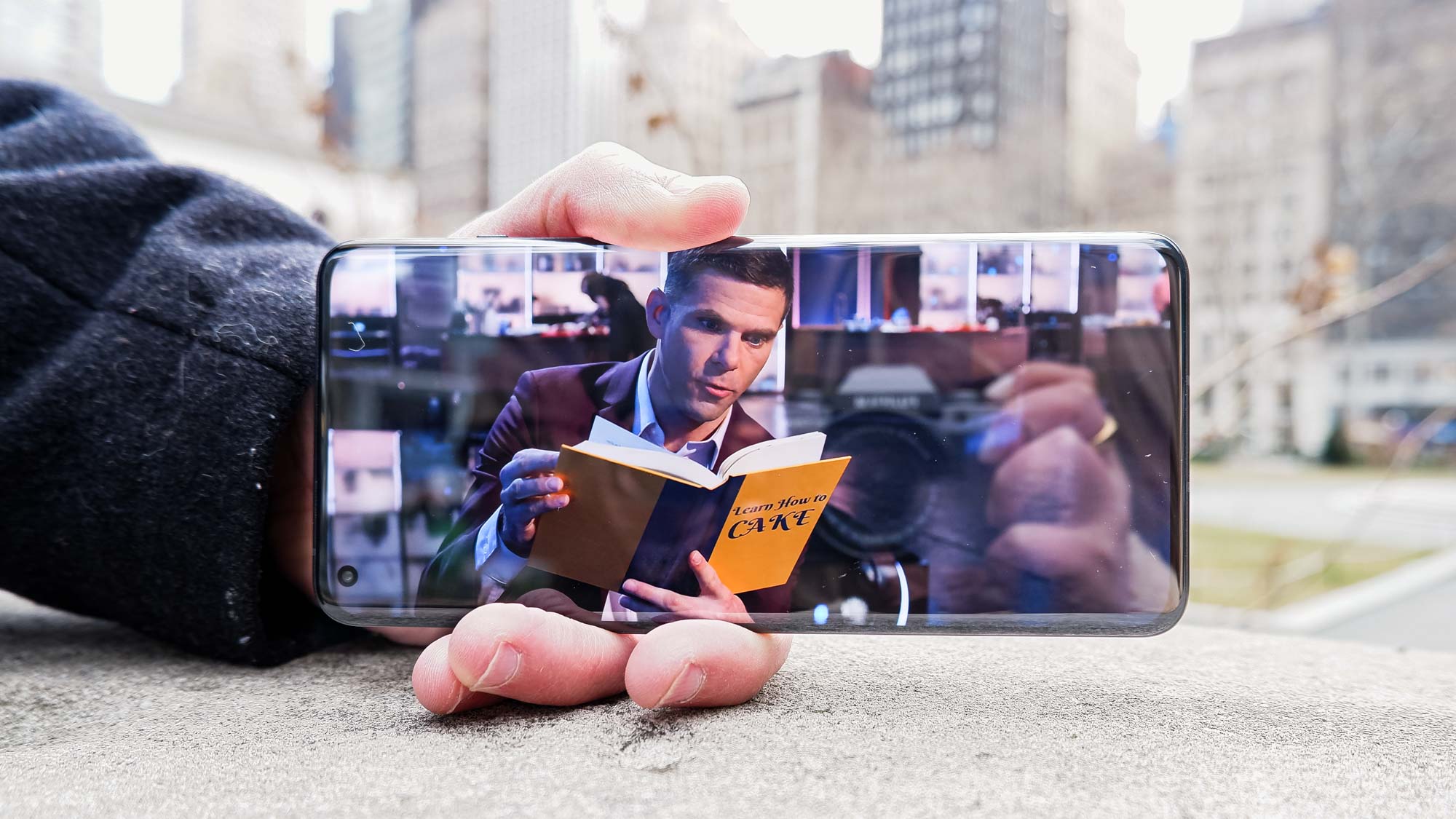
In our HDR testing of the newest Ultra, we measured 1,359 nits in the 10% field. It’s difficult to draw comparisons here because we were only able to measure the OnePlus 10 Pro’s HDR performance in the 100% field. HDR testing is a bit more nuanced than SDR benchmarks. Those, however, showed that the Galaxy S22 Ultra fell short of the OnePlus 10 Pro’s average peak brightness of 734 nits.
When I spoke with OnePlus, the company talked up the color calibration on the OnePlus 10 Pro. Not only are the colors extremely pleasing, but the phone also features two separate calibrations — one at 100 nits and the other at 500 nits. The point of this is to ensure that colors stay accurate whether the display is lit up or dimmed so that you don’t lose out on the visual fidelity of your content, regardless of your environment. Samsung features a similar technology with the Galaxy S22’s Vision Booster capabilities to intelligently boost colors, contrast, and brightness to compensate for sunlight without washing everything out.
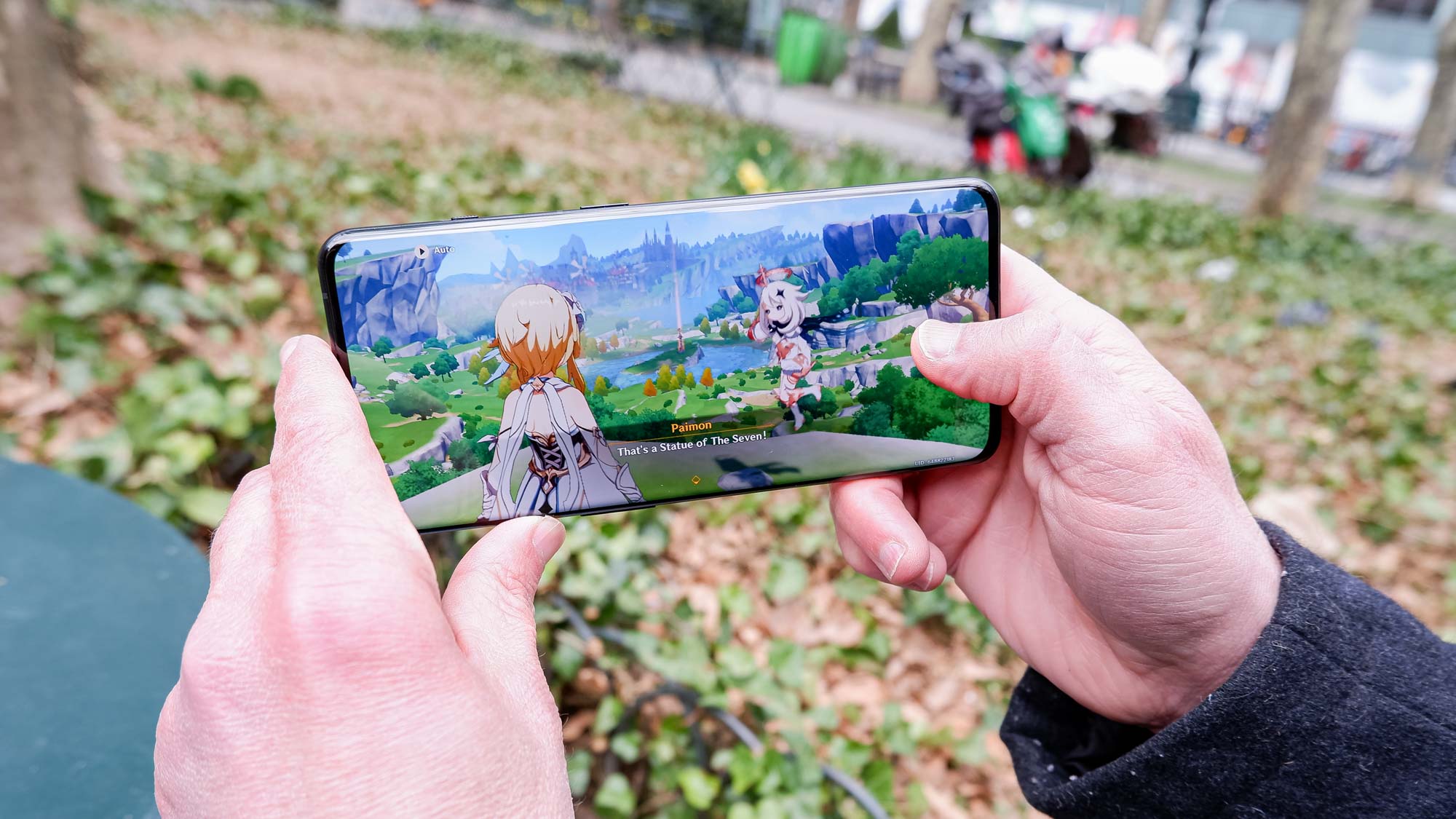
In practice, I like how the color calibration on the OnePlus 10 Pro works. The phone maintained most of Genshin Impact’s saturated color palette while playing the game in a darkened room. And as I watched a clip of The Return of the King out in broad daylight, the phone performed better than I expected given the rated peak brightness of 1,300 nits. I wouldn’t say OnePlus matched Samsung’s Vision Booster, but I had no trouble seeing the OnePlus 10 Pro’s display out in daylight while I was taking photos or watching videos.
Just watch out for the always-on display (AOD). In our experience, it appeared quite flickery when in low light.
OnePlus 10 Pro review: Cameras
Cameras are the biggest deal this year and OnePlus certainly came through. In short, the OnePlus 10 Pro is the best camera phone the company has ever produced. With a 48MP main camera, the phone takes photos that are almost on par with the likes of the Galaxy S22 Ultra, Pixel 6 Pro, and iPhone 13 Pro Max. The 50MP ultrawide camera can provide a 150-degree field of view, or 100 degrees with very minimal edge distortion.
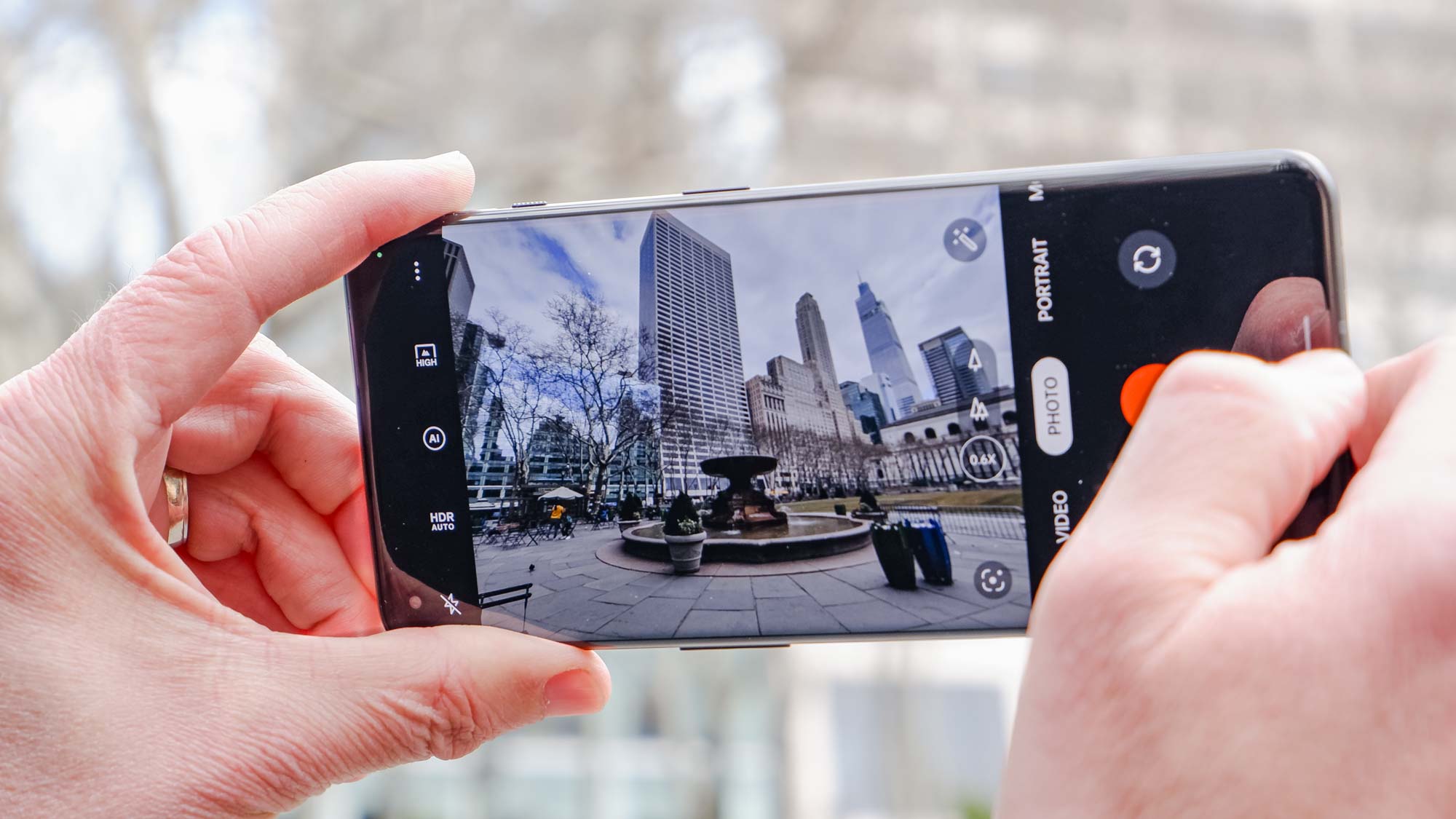
If I had to lodge one complaint against the OnePlus 10 Pro, it’d be that the telephoto sensor is 8MP as compared to the Galaxy S22 Ultra’s dual 10MP shooters. Telephoto lenses on the iPhone 13 Pro Max and Pixel 6 Pro are 12MP and 48MP, respectively. Megapixel count isn’t everything, but OnePlus is working at a disadvantage, which we’ll see. Around front, the OnePlus 10 Pro rocks a 32MP selfie cam.
OnePlus also has several software tricks up its sleeve. The main camera can shoot in 10-bit color (which saves in the HDIF format). The revamped Pro mode can shoot in 12-bit RAW and the new RAW+ mode gives the flexibility of RAW photos with some of OnePlus’ software enhancements like boosted dynamic range. But truly new this year is Master Styles, the OnePlus take on Apple’s Photographic Styles. These are essentially filter settings and color styles you can apply on the fly.
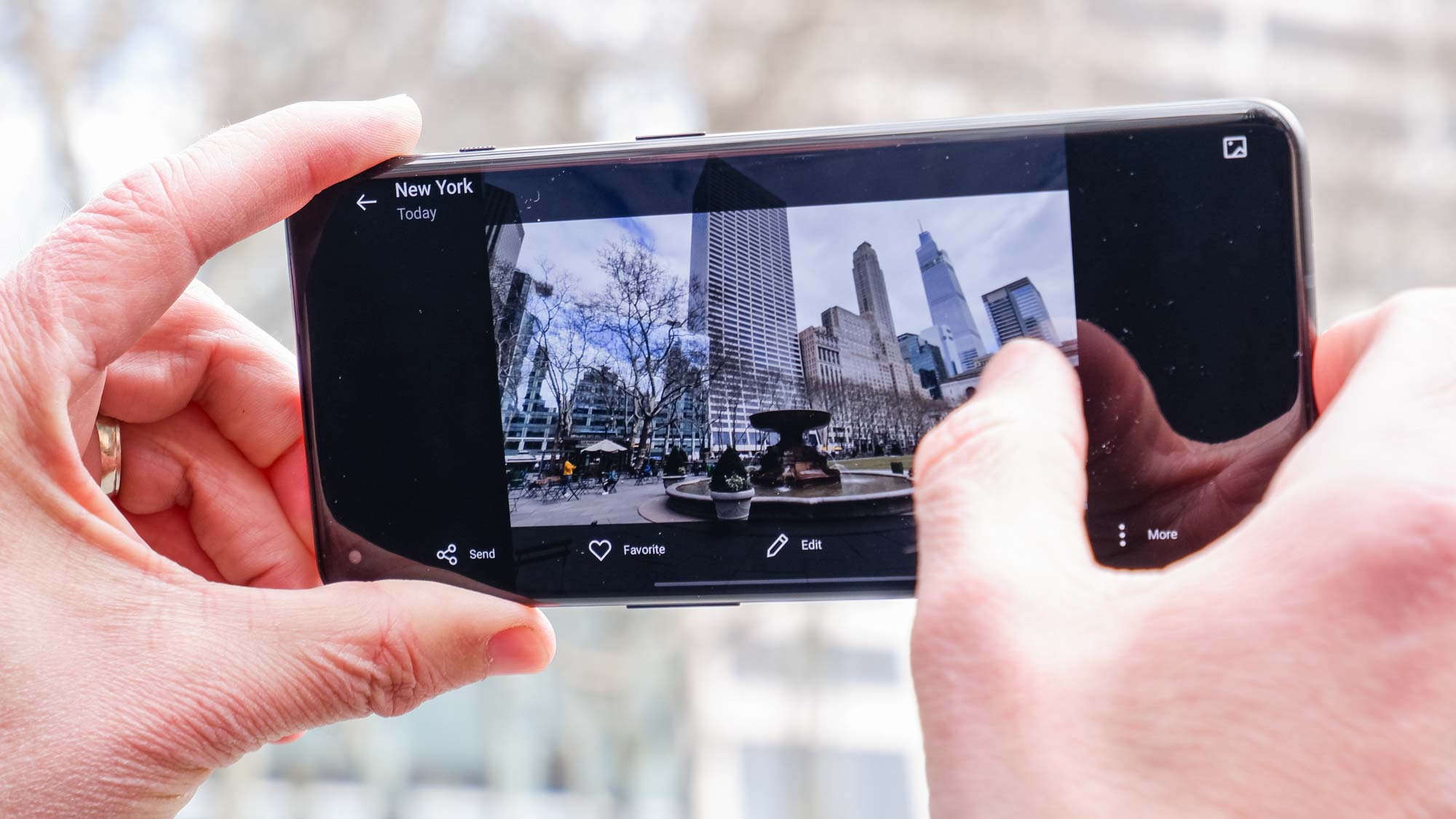
Since cameras are such a big deal this year, I brought out the three best camera phones you can buy: the iPhone 13 Pro Max, Pixel 6 Pro, and Galaxy S22 Ultra. Here’s how the OnePlus 10 Pro stacks up.
Starting with the first outdoor shot against the iPhone 13 Pro Max, the most obvious difference is that the OnePlus 10 Pro has a yellow tinge to its image. The trees in the background are a yellowy-green and the cherry blossom tree looks a bit too warm. It’s not a bad shot, but the iPhone wins out with crisper details and a cooler, more natural color profile. Still, this image from OnePlus is surprisingly good, but the warm tint from last year is still around.
For the second outdoor shot of this house, the OnePlus 10 Pro gave me a photo with some fuzzy and soft focus. The Pixel 6 Pro has a much sharper image with toned down colors. Once again, the OnePlus 10 Pro has some kind of yellow effect going on here, which you can see in the bush and the off-red in the bricks. To my eye, the tree in the foreground looks strangely pinkish in the OnePlus picture. Overall, OnePlus put up a good fight, but the Pixel 6 Pro wins out with better colors, stronger focus, and sharper details.
Heading inside, the OnePlus 10 Pro squared off against the iPhone 13 Pro Max for this shot of some of my books. In a surprise to me, I prefer the OnePlus photo. It’s not only brighter (taken on an overcast day with a warm lamp off to the left), but I can more clearly read the book spines thanks to the softer shadows. The iPhone 13 Pro Max looks harsh in comparison, making me go a bit cross-eyed trying to read the book titles. The iPhone has a bit wider focus, meaning that the books in the background look a tad better. But in the end, I give this one to the OnePlus 10 Pro.
For the second indoor face-off, I chose a much less flattering scene. This is a very dark room on a good day, plus there’s a fluorescent light right above this Mass Effect helmet. Neither the OnePlus 10 Pro nor the Galaxy S22 Ultra fared very well here, but I give the nod to Samsung. The carbon fiber detailing on the helmet looks a lot crisper in the S22 Ultra’s image, though OnePlus got the red stripe on the top of the helmet to look richer. Both phones did a good job with the colors on the manga volumes on the shelf below, but since I have to choose, the Galaxy S22 Ultra wins with its better brightness and stronger details.
Checking out the first ultrawide test, we’re back once again to OnePlus’ yellow effect. The iPhone 13 Pro Max produced a much cooler image while still capturing the yellow flowers beautifully. The grey clouds look a bit too blue, but even the bricks in the background look better. The OnePlus 10 Pro warmed everything up way too much. The grass looks a sickly yellow and the flowers look oversaturated, but the sky looks greyer. The iPhone wins out on this one. OnePlus really needs to dial back the yellow tint.
For this second ultrawide comparison, I activated the OnePlus 10 Pro’s 150-degree mode and pitted the Galaxy S22 Ultra against it. Due to the difference in the field of view, I won’t spend too long on this comparison, but the S22 Ultra’s grimmer image stands out to me when compared to the OnePlus 10 Pro’s slightly brighter image. Samsung did a better job with sharp focus, which I see in the details of the yellow paint. OnePlus applied too much smoothing on its photo.
If I had to label one weakness with the OnePlus 10 Pro’s cameras other than the yellow tint problem, it’d be the telephoto camera. In this first comparison with the Galaxy S22 Ultra (at 3x zoom), I notice the lower fidelity on the cherry blossoms in the OnePlus image. Samsung gave me a lot more detail in those blossoms, and it kept the colors toned down — this is growth on Samsung’s part. But with OnePlus, the image appears almost blurry and it still has a yellowy look that I don’t like.
For the second telephoto test, I brought out the Pixel 6 Pro at its max of 4x optical zoom. Both shots aren’t very good, but the OnePlus 10 Pro once again produced an image with less detail, with the Pixel 6 Pro picking up an edge in crispness. While the OnePlus photo is brighter and more inviting, the Pixel did a better job of capturing the details of the cherry blossom tree and the bricks beyond. Even the tree bark looks sharper. I don’t think the OnePlus 10 Pro’s 8MP telephoto sensor is up to the task against the likes of the Galaxy S22 Ultra and Pixel 6 Pro.
For the portrait test, I captured myself sitting in my chair. This is a good shot on both the part of the OnePlus 10 Pro and Pixel 6 Pro. The latter is only more appealing to me because of its better bokeh effect, but the OnePlus 10 Pro captured the details of my hair and the colors of The Expanse and The Wheel of Time books in the background very well. The Pixel 6 Pro zooms in a bit more for that artistic look, but I’m hard-pressed to pick a winner here. Both portraits are very good.
The Nightscape mode on the OnePlus 10 Pro is a vast improvement over the OnePlus 9 Pro’s. It’s far more consistent, and I think it actually beats out the Galaxy S22 Ultra in this image of my smoker at night. Samsung has the yellow tint problem this time, and the OnePlus shot is brighter with the smoker slightly clearer. The fence slats look sharper, too, though that could be down to how each phone handles the unsteadiness of my hands. Even the sliver of sky in the background looks better on the OnePlus 10 Pro’s picture.
Going into a very dark room, here’s the Mass Effect helmet in far less ideal conditions. Neither the OnePlus 10 Pro nor Pixel 6 Pro could handle the room lit up only by the RGB glow of my keyboard. I can’t crown a winner here because both are bad images, but it’s interesting to see that Nightscape produced much of the same details and brightness as the Pixel’s Night Sight.
Finally, the selfie competition came down to the OnePlus 10 Pro versus the iPhone 13 Pro Max. Both did a great job with the softer lighting conditions, but I think OnePlus came out on top. My face retains its ruddiness across both photos, though OnePlus applied too much smoothing. (You can adjust that setting, but I used out-of-the-box configurations for all of these comparisons.) OnePlus gave me a slightly brighter selfie where my blue eyes are more prominent. The shadows are also less harsh and the color profile is more welcoming and flattering. Disabling the face smoothing could have made for an even better selfie I think.
Finally, here's a sample of the new Master Styles on this scene of some early spring flowers.



Overall, I don’t think they’re on the level of Apple’s Photographic Styles — however, like Apple’s new feature, Mastery Styles are certainly situational. Filters are very personal things, so it’ll depend on you and your scene if the Master Styles prove useful.
OnePlus 10 Pro review: Video
When it comes to video, the OnePlus 10 Pro is no slouch on paper. It can record 8K footage at 30 frames per second, 4K at 120 fps, and 1080p at 240 fps. Coupled with Nightscape for low-light scenarios, I expected great things from this phone. OnePlus also took a page out of Samsung’s book with a dual camera recording mode, which lets you use the front and rear cameras simultaneously for your video. You can also save files in the LOG format for later editing.
Our current pick for the best video phone is the iPhone 13 Pro Max. I took a brisk walk outside for this test, seeing how each phone handles my stride, the outdoor noise, and the direct noon sunlight. I recorded at 1080p 60 fps.
I’d say the OnePlus 10 Pro did a great job with the video here, even if I think the iPhone 13 Pro Max did better with stabilization. Both phones had trouble with wind noise, but I thought the OnePlus 10 Pro had similar enough colors to the iPhone. Dynamic range was also good and I liked how clear the cherry blossom trees were.
OnePlus seems to have taken video seriously this year and it shows. Whether it’s the software features I mentioned earlier or the quality of the video I took, I came away very impressed with the OnePlus 10 Pro’s video performance.
OnePlus 10 Pro review: Performance
Powered by the Snapdragon 8 Gen 1 system-on-chip, the OnePlus 10 Pro is among the most powerful Android phones you can possibly buy. Paired with 8GB of RAM, it’s hard to find something that slows it down. For $899, this device is one of the better price-to-performance Android handsets.
We ran the OnePlus 10 Pro through the usual suite of benchmarks, the results of which you can see below.
| Row 0 - Cell 0 | OnePlus 10 Pro | Galaxy S22 Ultra | iPhone 13 Pro |
| Geekbench 5 (single-core / multicore) | 995 / 3482 | 1240 / 3392 | 1733 / 4718 |
| Adobe Premiere Rush (Mins:Secs) | 1:02 | 0:47 | 0:26 |
| 3DMark Wild Life Unlimited (Score / FPS) | 10,221 / 61 | 9499 / 57 | 11,693 / 70 |
| 3DMark Wild Life Extreme Unlimited (Score / FPS) | 2574 / 15 | 2346 / 14 | 2766 / 17 |
Based on our testing, the OnePlus 10 Pro falls behind the Galaxy S22 Ultra in CPU-intensive tasks like Geekbench and the Adobe Premiere Rush 4K-1080p transcoding tests. However, the OnePlus 10 Pro performed better in the gaming benchmarks, likely due to the new cooling system that helps keep the Snapdragon 8 Gen 1 cooler than what Samsung managed. That means the phone doesn’t have to throttle the chip as much, eking out more performance.
Of course, neither of these Android phones can beat the iPhone 13 Pro and its industry-leading A15 Bionic chipset. Even so, in most day-to-day applications, the OnePlus 10 Pro is about all the power you could possibly need.
When it comes to 5G, I’m not sure if the AT&T snafu from last year will persist this year. (The OnePlus 9 Pro did not support AT&T 5G.) OnePlus said the OnePlus 10 Pro will support T-Mobile out of the box and now the Verizon certification is official. However, at time of writing, there is no AT&T 5G support. You also will not find mmWave 5G on this phone.
OnePlus 10 Pro review: Battery life and charging
The OnePlus 10 Pro wowed me with its battery life, both in our testing and in my usage. The phone held up incredibly well to long gaming sessions, plus some YouTube and Plex viewing along the way. More casual use like web browsing and social media will see the OnePlus 10 Pro go for a very long time.
When we test a phone’s battery life, we set the display brightness to 150 nits and then task the device to endlessly reload web pages over a cellular connection. We run this test a few times to get our average. The OnePlus 10 Pro fared well, joining the iPhone 13 Pro on our best phone battery life list.
| Row 0 - Cell 0 | OnePlus 10 Pro (Adaptive / 60Hz) | Galaxy S22 Ultra (Adaptive / 60Hz) | iPhone 13 Pro |
| Battery life (Hrs:Mins) | 11:52 / 12:39 | 9:50 / 10:15 | 12:18 |
| Recharge percentage (15 mins) | 55 | 29 | 25 |
| Recharge percentage (30 mins) | 93 | 58 | 53 |
The OnePlus 10 Pro handily beats the Galaxy S22 Ultra in our battery rundown tests, despite having the same 5,000 mAh battery capacity and Snapdragon 8 Gen 1 chipset. We expect modern smartphones to hit at least 10 hours in this test, which the OnePlus 10 Pro easily exceeds. In its 120Hz mode, it’s almost to the iPhone 13 Pro’s impressive result, which is saying a lot.
OnePlus has long led the charge for what’s possible with charging technology, though the OnePlus 10 Pro arrives in the U.S. with a scaled back charging speed from the version that debuted in China. The US-version of the OnePlus 10 Pro comes equipped with 65W charging with the charging brick included and 50W wireless charging — the UK and EU version will support 80W. OnePlus told me that the 80W charging technology was not ready for the US power standards and it wasn’t all that better than 65W in their internal testing anyway. And our own testing seems to confirm that.

Basically, the 65W charger allows the phone to recharge almost completely from empty in just 30 minutes. So even when you do manage to run the battery down, you can top off in mere minutes.
OnePlus 10 Pro review: Software and special features
When OnePlus announced that it was merging with sister company Oppo, one of the things the companies promised is that Oppo and OnePlus devices would share a unified codebase. This would allow them to put out software updates faster, since OnePlus is a bit on the slower side. This, of course, led to concern that OnePlus’ OxygenOS software would start looking and acting too much like Oppo’s ColorOS. I even wrote about this a few months ago when I tried ColorOS 12 and OxygenOS 12 side-by-side. (I was not impressed.)
While the old OxygenOS is indeed dead, the software on the OnePlus 10 Pro is certainly a point in the phone’s favor. This is a time where I’m glad to have changed my mind. The interface is very clean, albeit a bit reminiscent of Samsung’s One UI. There are hints of Google’s vision for Android spread throughout the system, but the overall feel bears heavy resemblance to ColorOS. That’s not necessarily a bad thing.

The first thing that stood out to me was the new location for the OnePlus Shelf. Previously, it lived to the far left of your home screen where you normally find Google Discover. OnePlus has moved it to a right-hand pulldown in the status bar, similar to the Control Center on iOS. It takes some getting used to since I use my phone right-handed, which has led to accidental Shelf activations instead of the notification shade, but the Shelf has some useful information like weather, notes, some basic stats and widgets.
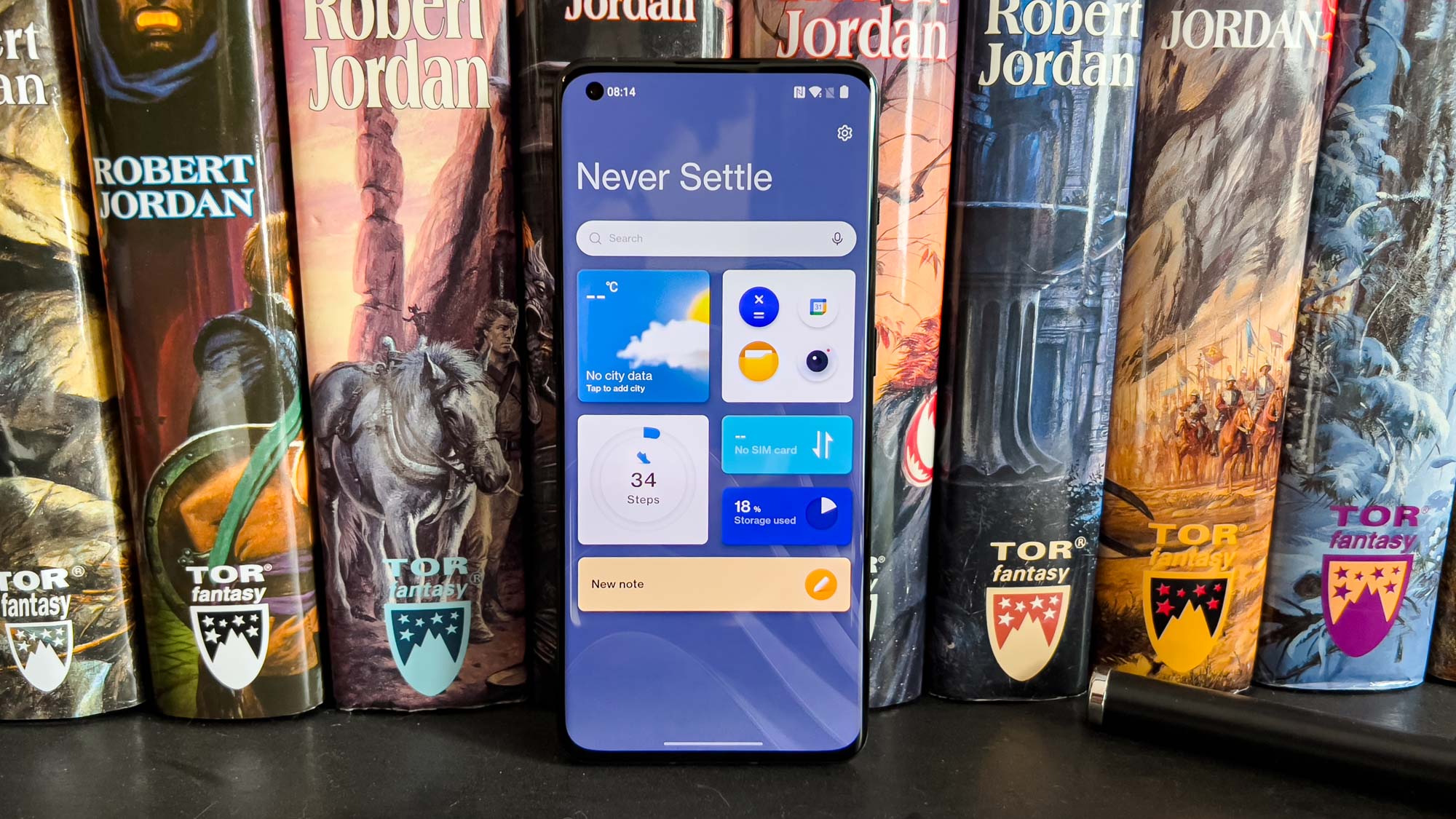
OxygenOS 12.1 ships standard on the OnePlus 10 Pro and features a lot of bug fixes and some community-requested additions. Chief among those are the new dark mode options. You can choose from three: Gentle (light grey), Medium (dark grey), and Enhanced (AMOLED black). The latter is the one that can net some small savings for battery life, since it takes advantage of the AMOLED display’s ability to show true blacks. All three options are very easy on the eyes, however, and I like that you have the option to select which one best suits your tastes — I’m partial to Gentle for the softer look that I can still see clearly in brighter conditions.
OnePlus hasn’t kept pace with Samsung in one key area: the software update policy for its phones. While Samsung now promises four years of platform (Android) updates and five years of security patches for its flagship phones, OnePlus is sticking with three years of platform updates plus an extra year of security updates. Samsung is now as close as any Android phone has gotten to the iPhone in terms of support life cycle, but OnePlus is standing still.
OnePlus 10 Pro review: Verdict
The OnePlus 10 Pro impressed me from the minute I took it out of the box. From benchmarks to the cameras, this phone is incredibly good. And now that it's only $799, it's arguably the best high-end Android phone for the money.
While I think the iPhone 13 Pro Max and Pixel 6 Pro are stronger camera phones overall, the OnePlus 10 Pro cameras are not an afterthought. The OnePlus 9 Pro started to change OnePlus’ reputation for mediocre camera quality, and the 10 Pro continues that push. It seems the Hasselblad partnership is paying off.
The OnePlus 10 Pro receives an easy recommendation from me. Cameras, battery life, display, this phone does just about everything right. It might lack the S Pen, but I think it gives the Galaxy S22 Ultra some serious competition, all for $300 less. OnePlus did a great job this year, even better than 2021. The OnePlus 10 Pro is my new favorite Android phone.
Next: Here's everything we know about the OnePlus 11 Pro that could launch in 2023.

Jordan is the Phones Editor for Tom's Guide, covering all things phone-related. He's written about phones for over six years and plans to continue for a long while to come. He loves nothing more than relaxing in his home with a book, game, or his latest personal writing project. Jordan likes finding new things to dive into, from books and games to new mechanical keyboard switches and fun keycap sets. Outside of work, you can find him poring over open-source software and his studies.

